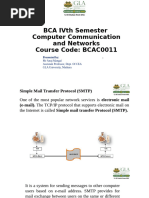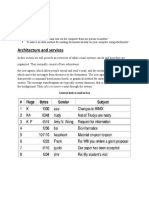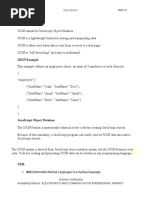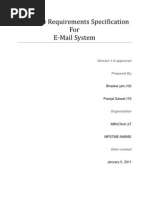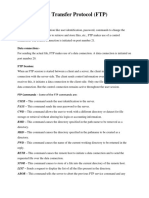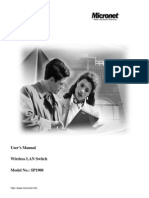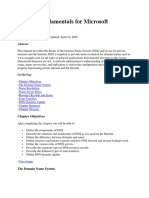Edwin H. Kremer Department of Computer Science Utrecht University
Edwin H. Kremer Department of Computer Science Utrecht University
Uploaded by
vijaychutarCopyright:
Available Formats
Edwin H. Kremer Department of Computer Science Utrecht University
Edwin H. Kremer Department of Computer Science Utrecht University
Uploaded by
vijaychutarOriginal Title
Copyright
Available Formats
Share this document
Did you find this document useful?
Is this content inappropriate?
Copyright:
Available Formats
Edwin H. Kremer Department of Computer Science Utrecht University
Edwin H. Kremer Department of Computer Science Utrecht University
Uploaded by
vijaychutarCopyright:
Available Formats
Towards Modern, Scalable Email Facilities
http://www.cs.uu.nl/technical/services/email/architecture/email.html
Edwin H. Kremer Department of Computer Science Utrecht University
<edwin@cs.uu.nl> February 23, 1998 January 12, 1999 (update)
1. Introduction
The use of electronic mail (email) at the Department of Computer Science at Utrecht University started early in 1985. Quite a few things have changed in the 12+ past years: in the late eighties it was rare to find a user with a mailbox of size over 200KB, now it is common to find mailboxes of size near to 25MB. Statistics on the Internet backbone show that the Email volume on the Internet is still rapidly increasing. The growth is causing us trouble... Chapter 2 describes our previous, traditional email environment, explains where the (daily) trouble occurs and where limits have been reached. Chapter 3 describes a modern, scalable, client/server based email environment; this is where we are migrating to. Chapter 4 summarizes the changes for the users.
2. Traditional Email Environment
In our previous email environment, all user mailboxes reside on a central server infix.cs.uu.nl, which makes the mailboxes available to all desktop UNIX workstations via the Network File System (NFS). To send mail, all desktop UNIX workstations have their own copy of sendmail on their local disk. UNIX users are running programs like elm, pine, Zmail, mailx and netscape to send and receive email. The non-UNIX systems (PC's and Apple's) heavily depend on network services on the central server infix.cs.uu.nl like POP and SMTP to respectively receive and send email (using Eudora or Netscape). Sendmail, the Mail Transfer Agent (MTA), the `core' program that takes care of sending the majority of email across the Internet, is one of the largest, security critical and most complex to maintain pieces of software that exist on the Internet. Figure 1 below shows this email environment in more detail.
1 of 4
3/6/2014 11:45 PM
Towards Modern, Scalable Email Facilities
http://www.cs.uu.nl/technical/services/email/architecture/email.html
There are quite a few areas where this configuration is growing beyond its limits: in performance, reliability and maintenance costs. Problems raised in these area's: Mailboxes have grown to huge sizes. Because all workstations are accessing the mailbox via NFS, reading mail and updating a mailbox causes a lot of network traffic. When the mailbox is very large (mailboxes with 500 messages and size of 15MB are quite common) this also takes a fair amount of time. As the load on the servers rises, processing time per mailbox increased rapidly. While the mailbox is being read, it is also locked to prevent concurrent updates when a new message arrives. In addition, NFS is notoriously known for its very unreliable locking behavior. On our busy network, the combination of huge mailboxes and NFS locking simply takes too long and is the cause of loss of email several times each day! NFS will hang a system. Because NFS is a very persistent protocol, the desktop workstation will suffer serious performance degradation or come to a grinding halt if the central mail server infix.cs.uu.nl is down. NFS is also not fully portable to heterogeneous environment and does little to nothing to address the needs of disconnected or nomadic users. Sendmail exists on every desktop system. As said before, sendmail maintenance is very time consuming and also a challenge, because it is very complex software. Sendmail tops the list of programs on the Internet that have had the most security problems in their lifetime, due to its complexity. An update of sendmail on all our systems takes about a full week of work, because it has to be compiled and installed for every architecture. Every desktop system has its own queue for outgoing email: this queue can fill up or come to a halt without being noticed easily. This will stop all user's email from being delivered. The local presence of sendmail is only required by ancient mail clients like elm, Zmail and mailx. There's no other reason why it should be there. Replacing these by modern mail clients, will eliminate this problem. Spam and UCE. Unsolicited Commercial Email (UCE) and `spam' is exploding. Abuse of our email facilities by spammers increases and it taking away a huge amount of resources. Preventing this is tricky and
2 of 4
3/6/2014 11:45 PM
Towards Modern, Scalable Email Facilities
http://www.cs.uu.nl/technical/services/email/architecture/email.html
is best done at a central server. Our goal is to eliminate the problems listed above and to provide a fast email environment that is dial-tone reliable and will cause a major decrease in Total Cost of Ownership (TCO).
3. Modern, Scalable Email Environment
The new email environment will offer substantial gains over the previous environment, like: Modern Client/Server Architecture. All email messages are retained on the mail server. Mail User Agents (clients) retrieve and submit messages to and from the store via reliable Internet protocols. Many operations that have traditionally been the responsibility of mail clients, such as searching and folder management, are now performed by the server, thereby making far more efficient use of network resources and specially tuned CPU performance. Built on Internet Open Standards. All components natively use Internet electronic messaging standards, including the Internet Message Text Definition (RFC822), Multipurpose Internet Mail Extensions (MIME), Extended Simple Mail Transfer Protocol (ESMTP) and Internet Message Access Protocol version 4, revision 1 (IMAPv4rev1). Supports Popular Mail Clients. The POP (Post Office Protocol) and IMAP (Internet Message Access Protocol) are supported by numerous clients on UNIX and Microsoft Windows95 and Apple Macintosh systems.
Figure 2 above shows the modern email environment in more detail. If you compare Figure 1 and figure 2, you will notice the following differences:
3 of 4
3/6/2014 11:45 PM
Towards Modern, Scalable Email Facilities
http://www.cs.uu.nl/technical/services/email/architecture/email.html
No Sendmail on the Desktop. Sendmail has been eliminated from all desktop systems, thereby reducing the TCO (Total Cost of Ownership). No NFS Mailbox Sharing. All mailboxes, both the normal `incoming' mailbox (/var/mail/user) and the users' `saved' mailboxes ($HOME/Mail/...) reside on the server. All file I/O operations are performed by the server. Initially, only the message headers are transferred across the network. Reduced Number of Email Tools on the Desktop. This is causing most of the pain for the users, because some of them will have to learn to use a different mail program. The reason for this is that development on tools like elm has stopped a couple of years ago. That software simply can't work in the modern environment. On the UNIX platform, pine is the most preferred mail client program. Using migrating from elm will master pine in only a couple of hours. The advantage is that pine can be used for news reading/posting too! Spam and UCE. Postfix (or sendmail) on the server side will be equipped with special restricted-rules that will stop spammers from abusing our site as a mail-relay and will stop UCE from well-known sites. Introducing IMAP. On the server side the IMAP server provides access to mailboxes trough the Internet Message Access Protocol version 4, revision 1 (IMAPv4rev1). Whereas the POP protocol downloads full messages from a single mailbox per user to the client system, the IMAPv4 protocols are considerably more flexible in downloading portions of messages, synchronizing after disconnected operation, updating the mailbox and maintaining a hierarchy of host message folders for the user. POP will typically be used by people who carry their own notebook computer and want to answer email while on the bus/train. IMAPv4 will typically be used by people who prefer to have their email at a single well defined, reliable (backups!) location - they will access their mail via the network, no matter if they are at the office, at home or somewhere abroad.
4. Brief Summary of Changes for Users
Users on the UNIX platform might have to learn how to use a different mail client program: choices here are pine, dtMail and Netscape 4.x. Personally, I prefer pine with Sun Solaris' dtMail being the runner-up. Users on Microsoft Windows95/NT and Apple Macintosh systems should consider moving from POP to IMAP: if your system is a desktop system, use of IMAP is preferred. If your system is a notebook computer that you take with you all the time, you might prefer POP instead (so that you always have all your mail local on the notebook). E-Mail services naming scheme, configuration hints and e-mail tips may be found in our E-Mail FAQ
edwin@cs.uu.nl $Id: email.html,v 1.1 1999/01/12 08:53:51 edwin Exp edwin $
4 of 4
3/6/2014 11:45 PM
You might also like
- Obeah Witchcraft in The West Indies by Hesketh Bell PDFDocument219 pagesObeah Witchcraft in The West Indies by Hesketh Bell PDFqm lo100% (1)
- HPE Intelligent Management CenterDocument1 pageHPE Intelligent Management CenterDaniel AgudeloNo ratings yet
- Mail ServerDocument44 pagesMail ServerGaurav Kishore100% (2)
- Pune Institute of Computer TechnologyDocument41 pagesPune Institute of Computer TechnologySHAIK CHAND PASHANo ratings yet
- Chapter2 - The TechnologyDocument14 pagesChapter2 - The TechnologyRaven Laurdain PasiaNo ratings yet
- Electronic Mail and TELNETDocument10 pagesElectronic Mail and TELNETK KiranmayiNo ratings yet
- Mail Server ReportDocument39 pagesMail Server ReportWan Yusri0% (1)
- SMTP Simple Mail Transfer ProtocolDocument5 pagesSMTP Simple Mail Transfer Protocoldiwaker100% (1)
- It Unit4Document13 pagesIt Unit4rogithaNo ratings yet
- Electronic Mail MP..Document14 pagesElectronic Mail MP..504 ,DALVI RUDRANo ratings yet
- Spanish VocabularyDocument7 pagesSpanish VocabularyLEH TvNo ratings yet
- Lecture 22 SMTPDocument8 pagesLecture 22 SMTPtusharsharma7018No ratings yet
- Comuter Network1Document5 pagesComuter Network1demoacc5043No ratings yet
- Mail ServerDocument22 pagesMail ServerMuhammad Firdaus Abd Halim100% (1)
- Network ProtocolsDocument12 pagesNetwork ProtocolsELIANA NASHANo ratings yet
- Chapter 6: Application LayerDocument10 pagesChapter 6: Application LayerRoshan BasnetNo ratings yet
- What Is E Mail?Document7 pagesWhat Is E Mail?Gaurav KulshreshthaNo ratings yet
- sendmailDocument4 pagessendmailSyed Muhammad UmerNo ratings yet
- Internet Fundamental Notes PDFDocument163 pagesInternet Fundamental Notes PDFNuzhat MirNo ratings yet
- Email PrezentacijaDocument25 pagesEmail PrezentacijaMarjan DjuricinNo ratings yet
- Unit 5 Client - Server Model & Network SecurityDocument18 pagesUnit 5 Client - Server Model & Network Securityall thinks waseNo ratings yet
- Internet Fundamental NotesDocument164 pagesInternet Fundamental NotesLalitha PonnamNo ratings yet
- MK-PPT Chapter 9Document97 pagesMK-PPT Chapter 9Aruna ShanmugakumarNo ratings yet
- SMTPDocument3 pagesSMTPdige83No ratings yet
- Comenzi Linux 2017 EmailDocument6 pagesComenzi Linux 2017 EmailGabriel AvasiloaeiNo ratings yet
- Lesson 03 Rev Final PDFDocument9 pagesLesson 03 Rev Final PDFThilan NawagamuwaNo ratings yet
- Activity 4 1 7Document4 pagesActivity 4 1 7Lexy Ira CapaoNo ratings yet
- How Mail Server Works:-: Mbox and Maildir Are Two Common Mailbox Format Used in UnixDocument11 pagesHow Mail Server Works:-: Mbox and Maildir Are Two Common Mailbox Format Used in UnixomkarNo ratings yet
- Untitled DocumentDocument16 pagesUntitled DocumentTeja DevandlaNo ratings yet
- Computer Network Case StudyDocument10 pagesComputer Network Case StudyAlan ANo ratings yet
- Netwoking GunDocument5 pagesNetwoking GunChishale FridayNo ratings yet
- Chapter 26: Remote Log-In, Electronic Mail and File TransferDocument34 pagesChapter 26: Remote Log-In, Electronic Mail and File Transferedsheeran23170% (1)
- What Is A Graphics Card?: 1. VGA 2. HdmiDocument9 pagesWhat Is A Graphics Card?: 1. VGA 2. Hdmisudhisugumar3006No ratings yet
- E-Mail ServerDocument32 pagesE-Mail ServerMehari TemesgenNo ratings yet
- World Wide Web Part 2Document11 pagesWorld Wide Web Part 2pawan sharmaNo ratings yet
- CCN_U4_SLVD_QBDocument28 pagesCCN_U4_SLVD_QBkmnawa0No ratings yet
- Internet Fundamental NotesDocument165 pagesInternet Fundamental NotesLalitha PonnamNo ratings yet
- UNIT 5 Final CNDocument20 pagesUNIT 5 Final CNShivamNo ratings yet
- Kuvempu University: E-Mail ConceptsDocument28 pagesKuvempu University: E-Mail ConceptsSharath KumarNo ratings yet
- ICF-9-week-1-2 - Q2Document13 pagesICF-9-week-1-2 - Q2Anna May BuitizonNo ratings yet
- Software EngineeringDocument21 pagesSoftware EngineeringmukundsinghkushwahaNo ratings yet
- Paper 2Document13 pagesPaper 2cebila9115No ratings yet
- More Information About IMAPDocument27 pagesMore Information About IMAPMayur KundarNo ratings yet
- Simple Mail Transfer Protocol (SMTP)Document13 pagesSimple Mail Transfer Protocol (SMTP)PK SNo ratings yet
- Computer Communication Network: E-Mail & INTERNET D. On Literacy DatabaseDocument8 pagesComputer Communication Network: E-Mail & INTERNET D. On Literacy DatabaseHimanshu Singh ChawraNo ratings yet
- Test Paper Anul 4, Var IIDocument5 pagesTest Paper Anul 4, Var IISErgeiNo ratings yet
- Telnet: "TELNET Is A General-Purpose Client/server Application Program."Document3 pagesTelnet: "TELNET Is A General-Purpose Client/server Application Program."devendra yadavNo ratings yet
- Computer NetworkingimpDocument11 pagesComputer Networkingimpsajjadshaikh1110No ratings yet
- Unit1 CNpart2 (1)Document27 pagesUnit1 CNpart2 (1)abinayasudhakar072No ratings yet
- 4.4 Electronic Mail in The InternetDocument4 pages4.4 Electronic Mail in The Internetsampath998No ratings yet
- How Email WorksDocument15 pagesHow Email Worksiratxe_sartaguda100% (1)
- Software Requirements Specification For E-Mail System: Bhaskar Jain, 105Document25 pagesSoftware Requirements Specification For E-Mail System: Bhaskar Jain, 105Bhaskar Jain100% (1)
- FTP&E MailDocument8 pagesFTP&E MailsuneelkluNo ratings yet
- How Email Works PDFDocument10 pagesHow Email Works PDFKavya AmmuNo ratings yet
- Abc2009 P7B PaperDocument3 pagesAbc2009 P7B PaperBudi HandukNo ratings yet
- Email: For The Former Manufacturing Conglomerate, SeeDocument18 pagesEmail: For The Former Manufacturing Conglomerate, SeePRIYANKNo ratings yet
- Mail EnableDocument87 pagesMail EnableJose Luis Rodriguez BarrazaNo ratings yet
- Email Protocols Understanding SMTP IMAP MIME Message Transfer Agent and User AgentDocument14 pagesEmail Protocols Understanding SMTP IMAP MIME Message Transfer Agent and User AgentSai Naresh PadakantiNo ratings yet
- Email Web Servers Isps: What Are The Types of Mail Servers?Document4 pagesEmail Web Servers Isps: What Are The Types of Mail Servers?Divya SharmaNo ratings yet
- Unit 9 Application LayerDocument3 pagesUnit 9 Application LayerarcybercafeakhtarNo ratings yet
- SP1900 ManualDocument129 pagesSP1900 ManualCheme UtmNo ratings yet
- Bypass 85.8Document52 pagesBypass 85.8Ngibul JagoNo ratings yet
- Government Receipt Portal SystemDocument1 pageGovernment Receipt Portal Systempetergr8t1No ratings yet
- FortiplusDocument6 pagesFortiplusAdrian AliasNo ratings yet
- SBC 2,3Document10 pagesSBC 2,3abNo ratings yet
- Cissp Domain 6 Security Assessment and TestingDocument8 pagesCissp Domain 6 Security Assessment and Testingsrivatsan_eceNo ratings yet
- IT Policy - Network Security PolicyDocument4 pagesIT Policy - Network Security Policygobang66No ratings yet
- Security Awareness SlogansDocument6 pagesSecurity Awareness SlogansannamyemNo ratings yet
- StealthWatch 7 1 Downloading and Licensing Guide DV 1 0Document53 pagesStealthWatch 7 1 Downloading and Licensing Guide DV 1 0Jaures HountondjiNo ratings yet
- Exchange 2007 Administrators Companion PDFDocument694 pagesExchange 2007 Administrators Companion PDFKhaja MoinuddinNo ratings yet
- Registration of A DAAD User Account (DAAD-ID) For A Personal Funding ApplicationDocument10 pagesRegistration of A DAAD User Account (DAAD-ID) For A Personal Funding Applicationsally kastounNo ratings yet
- TCP/IP Fundamentals For Microsoft WindowsDocument24 pagesTCP/IP Fundamentals For Microsoft WindowsJoel MangallayNo ratings yet
- How To Log in To Your CPanel Admin AreaDocument10 pagesHow To Log in To Your CPanel Admin Areaemlyn ngwiriNo ratings yet
- Upload A Document For Free Download Access.: Gaurav Kumar View Public ProfileDocument5 pagesUpload A Document For Free Download Access.: Gaurav Kumar View Public ProfileGaurav KumarNo ratings yet
- Digital Marketing GlossaryDocument17 pagesDigital Marketing GlossaryDhananjayKumarTiwariNo ratings yet
- Creating A Self-Signed Certificate Using Openssl For Use With Microsoft Internet Information Services (Iis) 5Document4 pagesCreating A Self-Signed Certificate Using Openssl For Use With Microsoft Internet Information Services (Iis) 5Nikhil PoojariNo ratings yet
- Purple Desk: The Right ChoiceDocument10 pagesPurple Desk: The Right ChoiceRejoy RadhakrishnanNo ratings yet
- ISO 9001 - ISO 14001 - ISO 27001 Online Training - AdviseraDocument18 pagesISO 9001 - ISO 14001 - ISO 27001 Online Training - AdviseramnamkyNo ratings yet
- Synopsis On CryptographyDocument25 pagesSynopsis On CryptographyVisitor Play0% (1)
- Manual Comand NmapDocument2 pagesManual Comand NmapCristhian ThoroNo ratings yet
- For Gov - in Secure Intrane T: National Informatics CentreDocument30 pagesFor Gov - in Secure Intrane T: National Informatics CentreRam Krushna DashNo ratings yet
- Isocsea Guidelines IndonesiaDocument1 pageIsocsea Guidelines IndonesiaNancy KawilarangNo ratings yet
- Employee Self Service (ESS)Document13 pagesEmployee Self Service (ESS)Charanpreet SinghNo ratings yet
- United States Patent: (10) Patent No.: US 8,352,379 B2Document14 pagesUnited States Patent: (10) Patent No.: US 8,352,379 B2jamesNo ratings yet
- PAM Vs IAMDocument5 pagesPAM Vs IAMrshonraoNo ratings yet
- ICT ASD QuestionnaireDocument5 pagesICT ASD Questionnaireabhijit desaiNo ratings yet
- PAN-OS® 8.0 CLI Quick StartDocument48 pagesPAN-OS® 8.0 CLI Quick StartguesieroNo ratings yet
- Yealink Device Management Platform Administrator Guide V3.5.0.11Document102 pagesYealink Device Management Platform Administrator Guide V3.5.0.11Miguel GomesNo ratings yet











